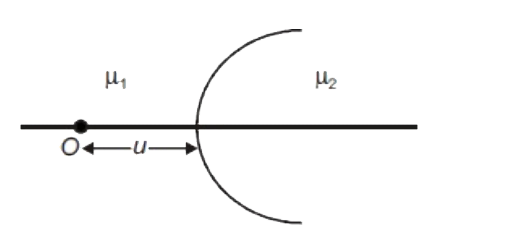The eye can be regarded as a single refracting surface is equal to that of cornea (7.8 mm). This surface separates two media of refractive indices 1 and 1.34. Calculate the distance from the refracting surface at which a parallel beam of light will come to focus.
1 cm
2 cm
4.0 cm
3.1 cm
To solve the problem, we need to calculate the distance from the refracting surface at which a parallel beam of light will come to focus, using the given parameters.
1. Identify Given Values:
- Radius of curvature (R) = 7.8 mm = 0.0078 m
- Refractive index of medium 1 (µ1) = 1
- Refractive index of medium 2 (µ2) = 1.34
2. Understand the Situation:
- A parallel beam of light is incident on the refracting surface (the eye).
- The object distance (u) for parallel rays is considered to be at infinity (u = ∞).
3. Use the Refraction Formula:
The formula for refraction at a spherical surface is given by:
μ2v−μ1u=μ2−μ1R
where:
- v is the image distance,
- u is the object distance,
- R is the radius of curvature.
4. Substituting the Values:
Since u=∞, μ1u becomes 0. Therefore, the equation simplifies to:
μ2v=μ2−μ1R
Substituting the known values:
1.34v=1.34−10.0078
5. Calculate the Right Side:
1.34−10.0078=0.340.0078≈43.59m−1
6. Set Up the Equation:
Now we have:
1.34v=43.59
7. Solve for v:
Rearranging gives:
v=1.3443.59≈0.0307m
8. Convert to Centimeters:
To convert meters to centimeters:
v≈0.0307m×100=3.07cm
Final Answer:
The distance from the refracting surface at which a parallel beam of light will come to focus is approximately 3.07 cm.
- Radius of curvature (R) = 7.8 mm = 0.0078 m
- Refractive index of medium 1 (µ1) = 1
- Refractive index of medium 2 (µ2) = 1.34
- A parallel beam of light is incident on the refracting surface (the eye).
- The object distance (u) for parallel rays is considered to be at infinity (u = ∞).
The formula for refraction at a spherical surface is given by:
μ2v−μ1u=μ2−μ1R
where:
- v is the image distance,
- u is the object distance,
- R is the radius of curvature.
Since u=∞, μ1u becomes 0. Therefore, the equation simplifies to:
μ2v=μ2−μ1R
Substituting the known values:
1.34v=1.34−10.0078
1.34−10.0078=0.340.0078≈43.59m−1
Now we have:
1.34v=43.59
Rearranging gives:
v=1.3443.59≈0.0307m
To convert meters to centimeters:
v≈0.0307m×100=3.07cm
The distance from the refracting surface at which a parallel beam of light will come to focus is approximately 3.07 cm.
Topper's Solved these Questions
- JEE MAINSBook:JEE MAINS PREVIOUS YEAR ENGLISHChapter:JEE MAINSExercise:Chemistry
Explore 1 Video
- JEE MAINBook:JEE MAINS PREVIOUS YEAR ENGLISHChapter:JEE MAINExercise:All Questions
Explore 452 Videos
- JEE MAINS 2020Book:JEE MAINS PREVIOUS YEAR ENGLISHChapter:JEE MAINS 2020Exercise:PHYSICS
Explore 250 Videos
Similar Questions
A convex surface of radius of curvature 40 cm separate two media of refractive indices 43 and 1.50. An object is kept in the first medium at a distance of 20 cm from the surface. Calculate the position of the image.
View SolutionA concave spherical surface of radius of curvature 100 cm separates two media of refractive indices 1.50 and 43. An object is kept in the first medium at a distance of 30 cm from the surface. Calculate the position of the image.
View Solution
Knowledge Check
A convex refracting surface of radius of curvature 20cm separates two media of refractive indices 4/3and1.60. An object is placed in the first medium (μ=4/3) at a distance of 200cm from the refracting surface. Calculate the position of image formed.
A120cmB240cmC100cmD60cmThe radius curvature of each surface of a convex lens of refractive index 1.5 is 40 cm. Calculate its power.
A2.5DB2DC1.5DD1D
Trace the rays of light showing the formation of an image due to a point object placed on the axis of a spherical surface separating the two media of refractive indices n1andn2. Establish the relation between the distance of the object, the image and the radius of curvature from the central point of the spherical surface.
Hence derive the expression of the lens maker's formula
View SolutionA spherical convex surface separates object and image space of refractive index 1.0and43. If radius of curvature of the surface is 10cm, find its power.
View SolutionA spherical convex surface separates object and image space of refractive index 1.0and43. If radius of curvature of the surface is 10cm, find its power.
View SolutionIf a ray of light is incident from rarer medium at an angle 45° on the surface which separates two medium having refractive indices 1 and √2 for rarer and denser medium, then angle of deviation of refractive ray with incident ray is
View SolutionThe diagram shows a spherical surface which separates two media of refractive index, μ1andμ2. Respectively. Now, a point object is placed on the principal axis as shown in the figure. Then

View SolutionA point object is placed at the center of a glass sphere of radius 6cm and refractive index 1.5. The distance of virtual image from the surface is
View Solution
